
Vietnam Mission Hero - Captain charlie plumb,
FORMER FIGHTER PILOT, KEYNOTE SPEAKER SEMINAR LEADER, SIX-YEAR PRISONER OF WAR
A great war hero of Vietnam. Fight much war for Vietnam.
One time when he goes to fight, his plane crash, but he still lives from this fight.
After a couple of years later, one time he goes to eat in a restaurant. One waiter come together and say,
"Sir, are you Vietnam Mission HERO, right?"
Charlie plumb answered," yes, but I Am not a hero, I am a fighter."
Waiter asked, "Sir, are you know me?"
Charlie Plumb replies, "I am sorry, but I don't know you."
The waiter said, "sir, I am the man who tied the parachute during your last flight."
Charlie Plumb stood up and hugged the waiter. He fed the waiter and thanked him, saying,
"Maybe it's because of you that I'm alive today."
Be thankful like that.
We never say Thank you to any kind of help.
Getting significant achievement, we never say thank you to a person who is work for you.
Never forget it. Be thankful
As a leader, you need to function as a goal setter, organizer, and many more. Being a leader cannot be simple. It is very important to be perfect in every aspect to tackle your goals. So, learning leadership qualities is also better for developing yourself.
Before you develop these skills, you must know what functions have been performed by a leader.
Following are the important functions of a leader:
• Setting Goals.
• Organization of work.
• Initiating Action.
• Co-Ordination.
• Direction and Motivation.
• Proper Management of work and management of Workers.
• Motivation and Morale.
• Adds a Motive Power to Group Efforts.
To become a good leader you need to develop some qualities in yourself. Here are some of the qualities which will help you to focus on those skills which will help you to develop into a leader. We have brought some of the common skills which you will notice in each and every leader out there. These are the skills that will help you to develop some leadership skills and help you to walk towards your goals.
Leadership Skills Found in Managers:
• Communication: One of the most important skills of a leader is the ability to communicate well
• Awareness.
• Honesty/Integrity.
• Relationship Building.
• Innovation.
• Developing Leadership Skills.
These are the skills that you have to improvise within you to develop the leader in you.
Leadership is a skill that helps us to achieve our goal. It becomes necessary in every aspect of life and has its importance in professional life also. True leaders have integrity they are forthright with their people. They also communicate openly and often.
14 Leadership Traits are:
1. Justice.
2. Judgment.
3. Dependability.
4. Initiative.
5. Decisiveness.
6. Tact.
7. Integrity.
8. Enthusiasm.
9. Empathy.
10. Understanding.
11. Co-operative.
12. Positive attitude.
13. Handling the situation wisely.
14. Problem solver.
These are the 14 traits of the leadership which helps us to know what a leader is all about. These are the very common traits of all the leaders. Focus on these traits and develop these abilities and skills within you to become a good leader.

Discover the crucial role of effective leadership in maximizing overall success. Discover how your leader can empower and support your growth journey.
Becoming an exceptional leader requires honing specific skills, yet it also demands attention to numerous essential aspects.
A great leader possesses a clearly defined vision and demonstrates courage and honesty.
7 Essential Practices for Exceptional Leadership:
Recognition: Always express gratitude for the efforts of everyone on your team.
Encouragement: Provide continuous motivation to enhance productivity levels.
Clarity in Communication: Ensure clear, professional communication, coupled with a friendly demeanor.
Confidence in Team: Foster a culture of trust in your employees.
Empowerment: Equip your team members for success and inspire them to elevate their productivity.
Precision: Practice clear and straightforward guidance.
Collaboration: View your employees as partners in your endeavors.
Effective leaders embody integrity and humility, unafraid to recruit individuals who excel beyond themselves. By focusing on these principles, you can cultivate your leadership skills.
When you need any help then just ask for it. Many leaders do this. Rather than struggling for it and postponing the decided work, ask for help and complete the work on time. Do not hesitate to ask for help when you need it. Here are some of the tips which will help you on how to ask for help.
These tricks are been used by many great leaders and it will surely help you too.
How Strong Leaders Ask For Help:
• Strong Leaders Ask for Help Rather than Struggle and Miss Strategic Goals and Timelines.
• Be Specific About What Help You Need.
• Summarize What You Know and What You've Tried.
• Choose Optimum Time for asking help and be specific.
• Give everything that is needed for help.
Whenever you are in a problem or whenever you need any help, go through this list and figure out what you actually need and ask for it.
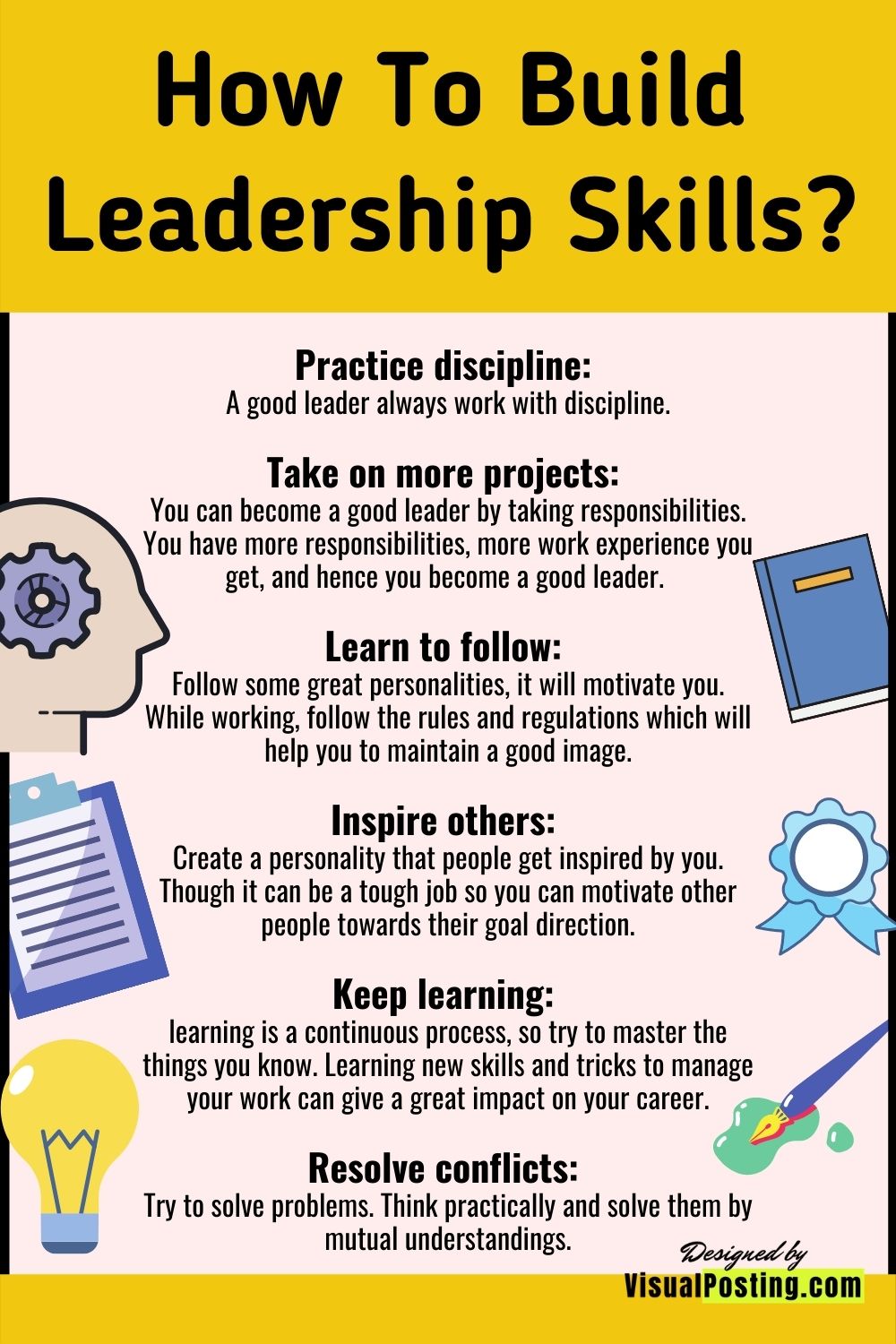
Here are 6 Ways to Develop Your Leadership Skills:
1. Practice discipline: A good leader always work with discipline.
2. Take on more projects: You can become a good leader by taking responsibilities. You have more responsibilities, more work experience you get, and hence you become a good leader.
3. Learn to follow: Follow some great personalities, it will motivate you. While working, follow the rules and regulations which will help you to maintain a good image.
4. Inspire others: Create a personality that people get inspired by you. Though it can be a tough job so you can motivate other people towards their goal direction.
5. Keep learning: learning is a continuous process, so try to master the things you know. Learning new skills and tricks to manage your work can give a great impact on your career.
6. Resolve conflicts: Try to solve problems. Think practically and solve them by mutual understandings.
Learn essential strategies for developing your personality as a leader. Enhance communication, empathy, and decision-making skills for effective leadership.
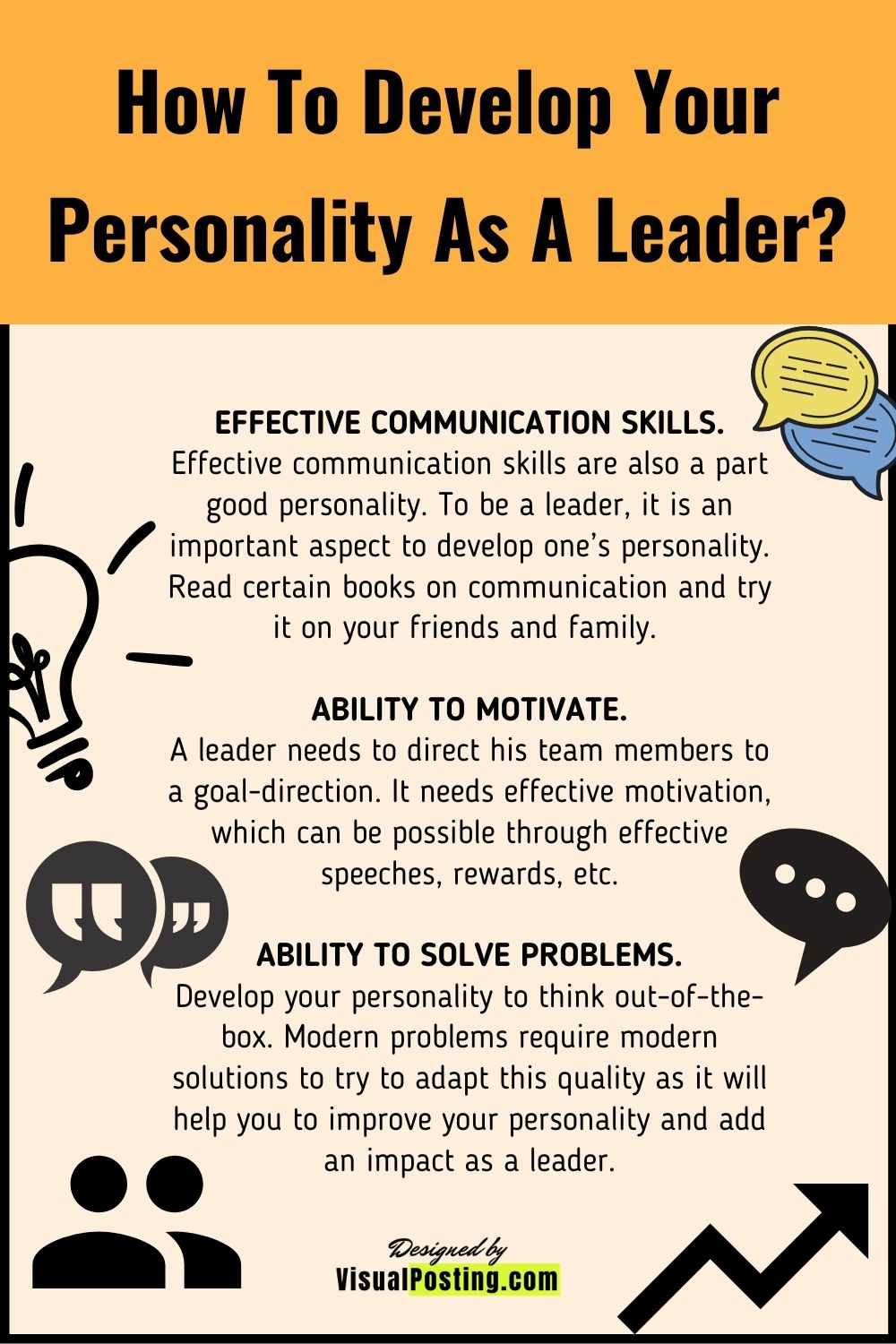
To become a leader, you need to develop a personality. Sometimes your personality is developed after being a leader. So we have brought you some amazing tips and tricks which will develop your personality as a leader.
The tips and tricks include:
• Effective communication skills.
Effective communication skills are also a part good personality. To be a leader, it is an important aspect to develop one’s personality. Read certain books on communication and try it on your friends and family.
• Ability to motivate.
A leader needs to direct his team members to a goal-direction. It needs effective motivation, which can be possible through effective speeches, rewards, etc.
• Ability to solve problems.
Develop your personality to think out-of-the-box. Modern problems require modern solutions to try to adapt this quality as it will help you to improve your personality and add an impact as a leader.

Dealing with difficult team members is challenging. Getting them together, along with other members of your team is going to be difficult initially. This is where a team’s leadership skill comes into the scene. Effectively handling difficult team members will add more respect from other people in the team. Before that, observe your team for some time.
You will find the following types of Difficult Team Members.
1. Attention Seekers
2. Argumentative Kind
3. ‘I Know Everything’ Type
4. Shy/Secluded Nature
5. Dominators
6. Unproductive & Irresponsible
7. The Constant Challengers of Ideas, Opinions, and Discussions
8. Over-Qualified, Over-Achievers
9. The Devil’s Advocate
10. Silent Spectators
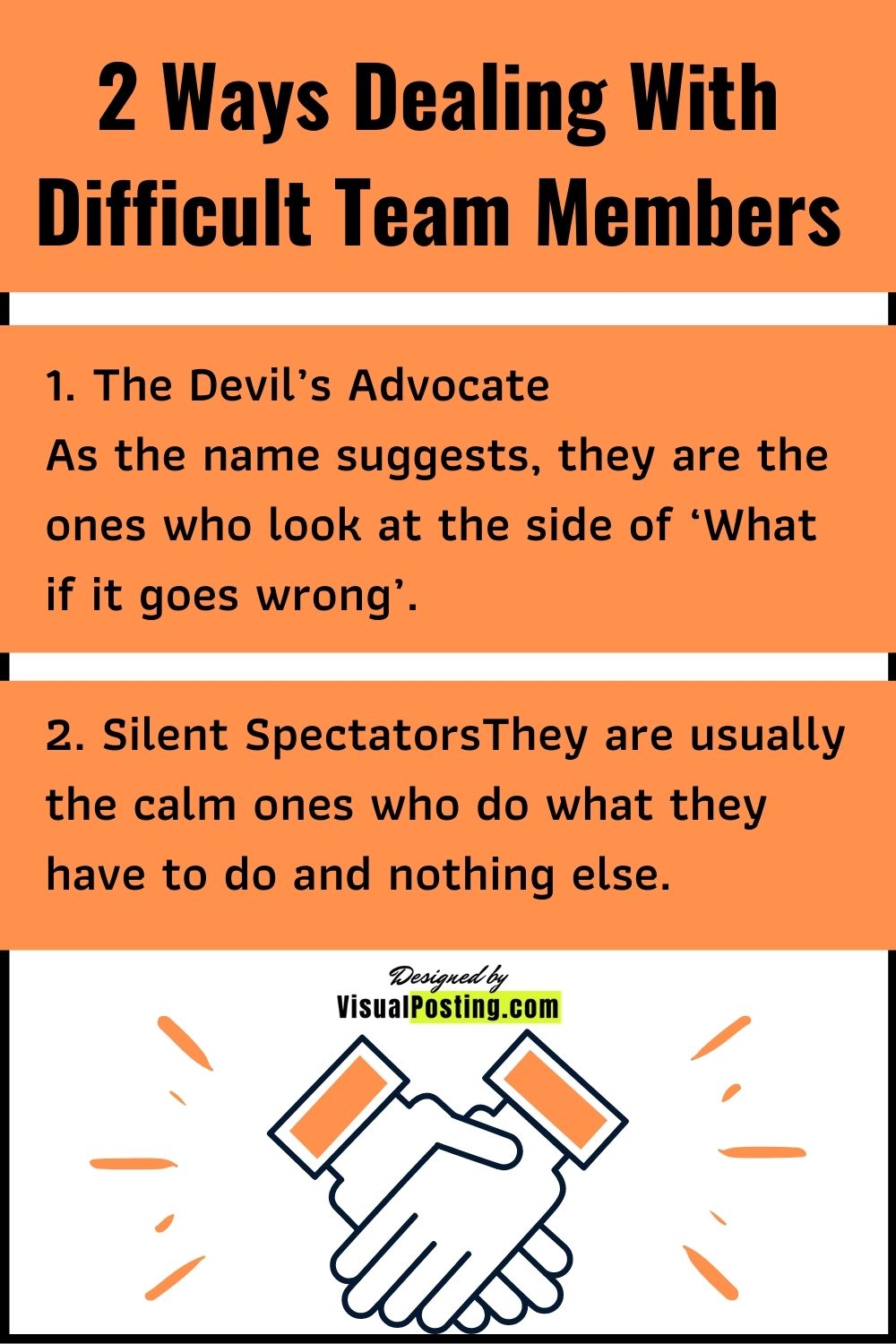
1. The Devil’s Advocate
As the name suggests, they are the ones who look at the side of ‘What if it goes wrong’.
How to handle this difficult team member?
Such an attitude people are good in a way of bringing new perspectives that we would have never thought. Supporting the opposite side and arguing will help the team understand the details even better. They can help us find the things that we missed. They don’t need any special handling. Let them go with the flow.
2. Silent Spectators
They are usually the calm ones who do what they have to do and nothing else.
How to handle them?
Silent spectators or the neutral ones will not hinder fellow team members in any way. Voicing ideas and opinions can be a little less from them. They seem to agree with what has been concluded by the team. They usually play a safe game. You won’t have any trouble handling them. You just have to motivate them a little when needed.
If we look closely, we can see that almost all kinds of difficult team-members fall under these categories. Handle difficult team embers without affecting the team’s performance or morale. The point here is you have to point out the difficult team members and their behaviors. Meanwhile, you have to make sure that they try to change and take it positively instead of creating a big mess.
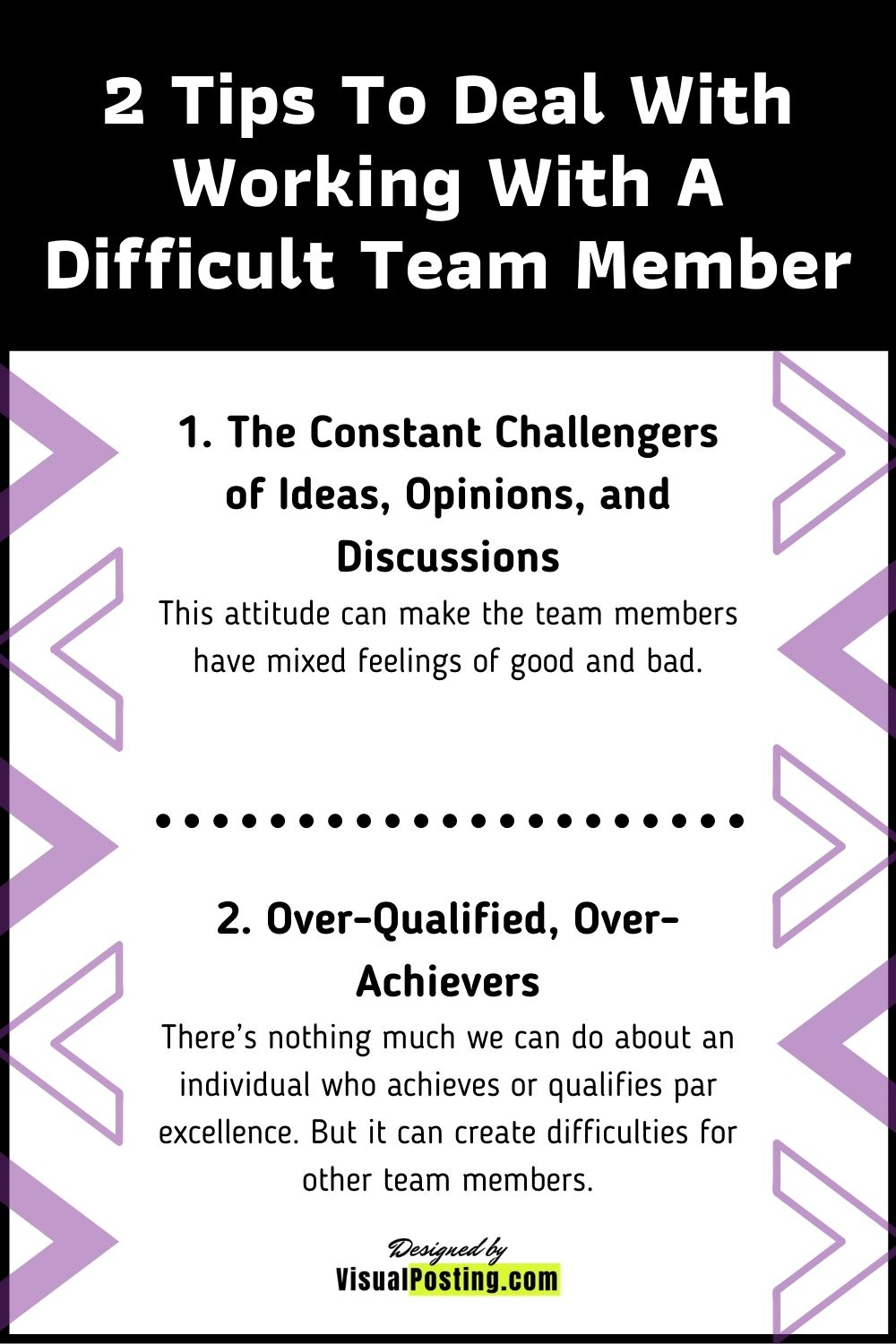
1. The Constant Challengers of Ideas, Opinions, and Discussions
This attitude can make the team members have mixed feelings of good and bad.
How to Handle such Challenging and Difficult Team Members?
Observe the tone i.e. if it’s in a positive or negative tone. If it is a positive note, then let them place their arguments or challenges over the issue. They should have a valid reason behind it. Give space for them to convey the reason for channeling. If it is a negative note i.e. they simply challenge everything to show their presence or expertise, simply move on. Don’t give more attention to such an attitude.
2. Over-Qualified, Over-Achievers
There’s nothing much we can do about an individual who achieves or qualifies par excellence. But it can create difficulties for other team members.
How to Handle such Challenging Team Member?
Follow the attitude of ‘every team member has their own pace of achieving things’. Bias towards super-achievers should be avoided. Comparisons should be avoided. Make sure that the super-achievers or over-qualified people don’t hurt other team members in any way or show dominance.
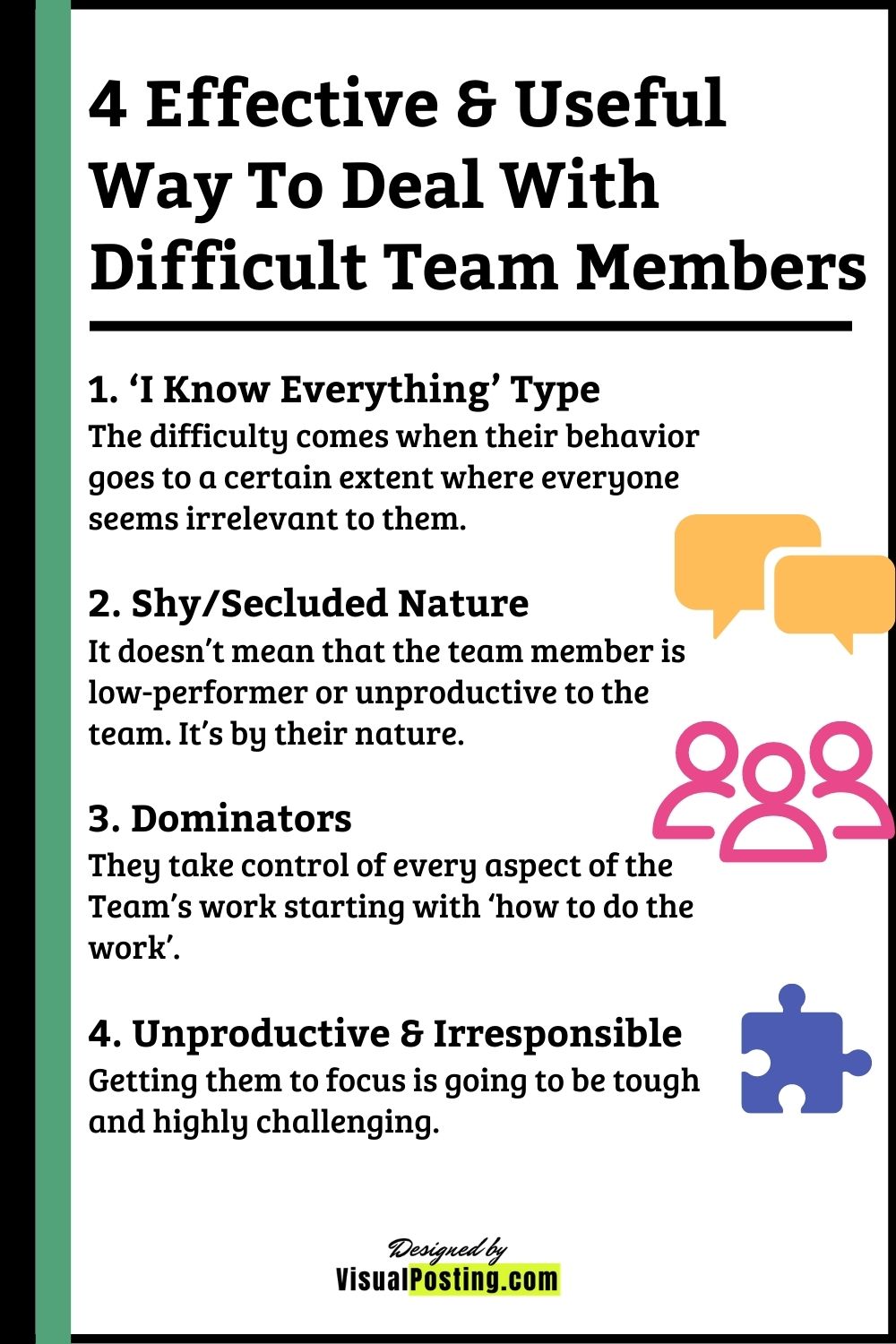
1. ‘I Know Everything’ Type
The difficulty comes when their behavior goes to a certain extent where everyone seems irrelevant to them.
How to Handle this Difficult Team Member?
Ask questions to them like ‘what are you trying to prove here’ or ‘why are you so passionate about this’ or ‘why we have to listen to you’. Discuss with the team and find ways to put the ‘I know everything’ attitude positively.
2. Shy/Secluded Nature
It doesn’t mean that the team member is low-performer or unproductive to the team. It’s by their nature.
How to Handle such Difficult Team Member?
When it comes to Shy/Secluded type of team members, it doesn’t mean they are unproductive. Team members like them can be handled by arranging small groups and discussions. Instead of putting those before the entire team where they tend to shut themselves try this method of handling. Among others, the shy/secluded team members will need time to settle. Try giving them time and observe their progress.
3. Dominators
They take control of every aspect of the Team’s work starting with ‘how to do the work’.
How to handle this difficult team member?
At some point, you have to handle this dominant team member face-to-face. Do it in private. Be direct in explaining their nature and how it is affecting their team and members.
4. Unproductive & Irresponsible
Getting them to focus is going to be tough and highly challenging.
How to Handle this Difficult Team-Member?
Address the issue directly to them. Give your attention. Give them responsibilities that they have to handle every day. Observe how they work. Give them short to long tasks and make them do it in stipulated time. If they remain unproductive and irresponsible even after your intervention, then take it to your immediate head or the HR.
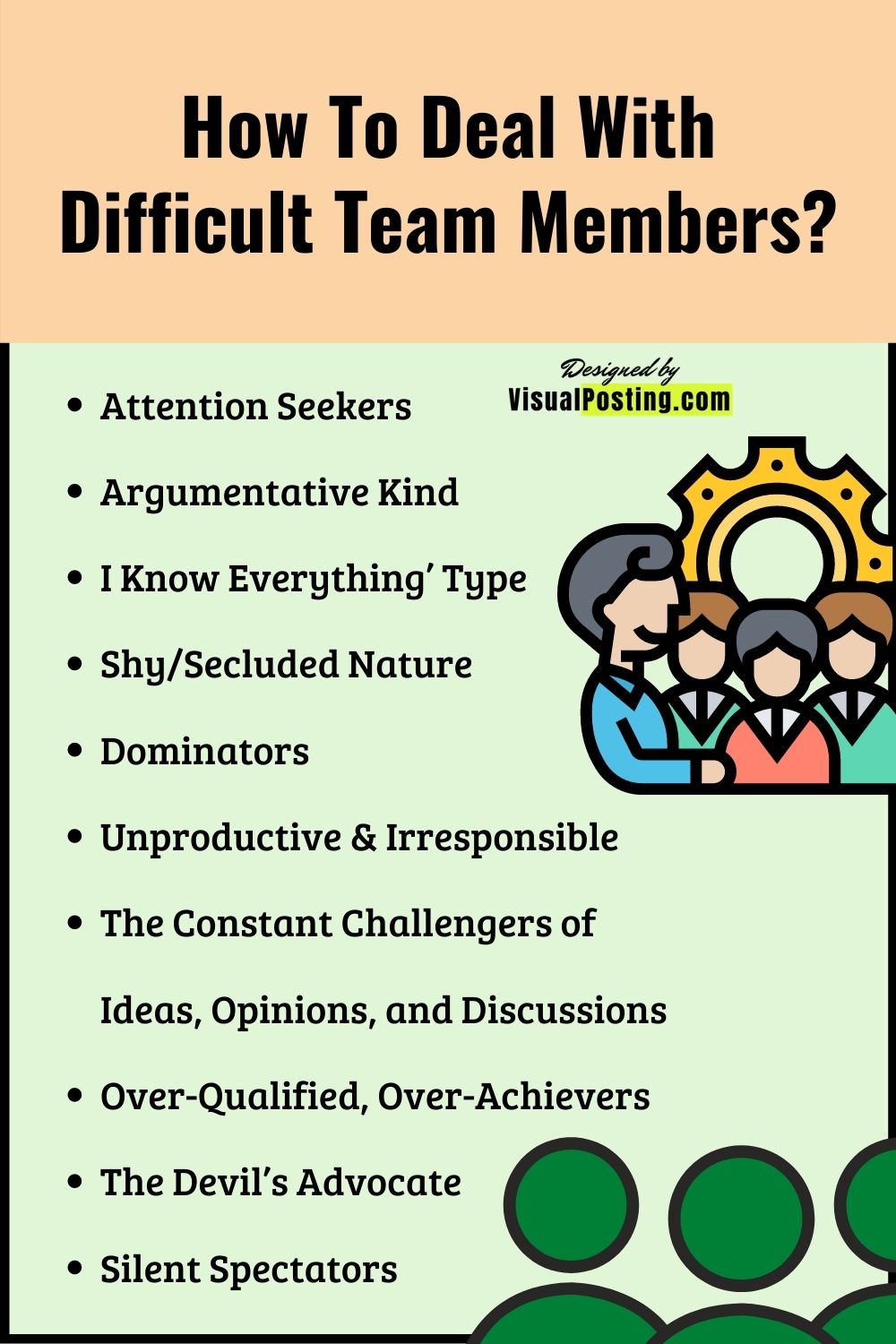
Dealing with difficult team members is challenging. Getting them together along with other members of your team is going to be difficult initially. This is where a team’s leadership skill comes into the scene. Effectively handling difficult team members will add more respect from other people in the team. Before that, observe your team for some time.
1. Attention Seekers
These types don’t care about what’s happening around. All they want is attention. They want to be seen, recognized and appreciated all the time. It is difficult.
How to handle this difficult team member?
Try giving them work in the same pattern of theirs i.e. attention-seeking works like making them open a presentation, or let them keep track of presentation flow or keeping time and such. Handle them by giving works like these. They will feel good as well as not disturb others.
2. Argumentative Kind
All they do is arguing. They argue even in a place where there is no need for any arguments. Other kinds of argumentative people become dominant i.e. they argue for what’s right to them.
How to handle this Difficult Team Member?
When it comes to meetings, presentations or discussions
Make them stop at some point quickly. Tell them to get to the point. Ask them about what they are trying to convey in short. Cut them short to the core instead of letting them argue.
During Work
If they keep arguing for everything like the work assigned, about co-workers or other tasks, at some point you have to deal with this in private. Call them.
Explain to them in private about how their behavior is hindering other team members.
If it’s a valid or positive argument, take it. Else, move on from such argumentative kinds.
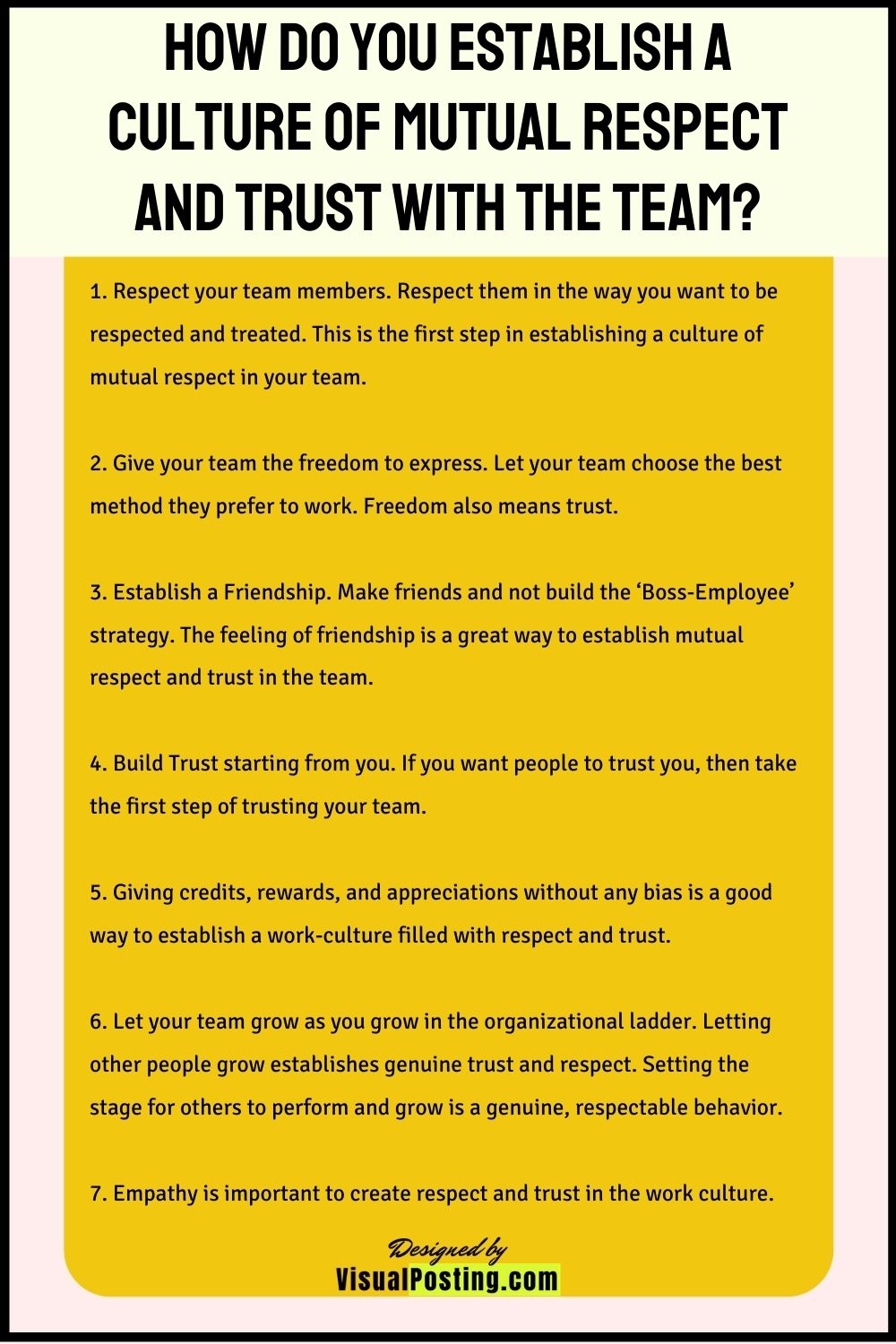
Establishing a culture of mutual respect and trust is a foundation to build strong, successful teams. To make your team a place of mutual respect and trust, start by understanding your team and treating them with value and respect as your own self.
10 ways to successfully establish a Culture of Mutual Respect and Trust with the team:
1. Respect your team members. Respect them in the way you want to be respected and treated. This is the first step in establishing a culture of mutual respect in your team.
2. Give your team the freedom to express. Let your team choose the best method they prefer to work. Freedom also means trust.
3. Establish a Friendship. Make friends and not build the ‘Boss-Employee’ strategy. The feeling of friendship is a great way to establish mutual respect and trust in the team.
4. Build Trust starting from you. If you want people to trust you, then take the first step of trusting your team.
5. Giving credits, rewards, and appreciations without any bias is a good way to establish a work-culture filled with respect and trust.
6. Let your team grow as you grow in the organizational ladder. Letting other people grow establishes genuine trust and respect. Setting the stage for others to perform and grow is a genuine, respectable behavior.
7. Empathy is important to create respect and trust in the work culture.
8. Listening helps develop mutual respect and trust. Do it often. Listen genuinely from your team.
9. It is essential to know your team at least in a basic personal level. The more you know about each team member and what’s happening with them, you will share more respect and trust.
10. Connect. It’s an effective way to establish a work culture with respect and trust. Make your team space of well-connected dynamic individuals.
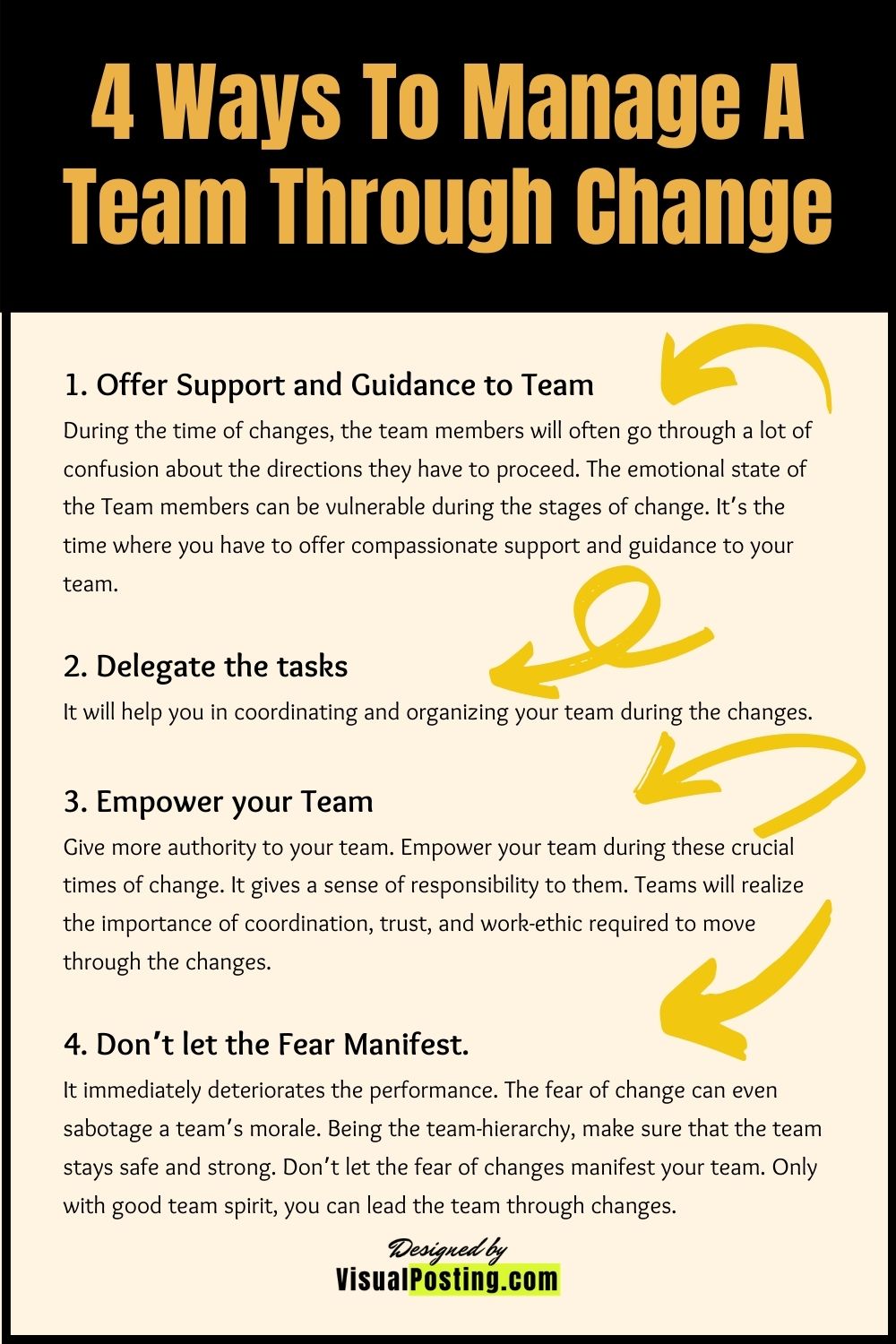
1. Offer Support and Guidance to Team
During the time of changes, the team members will often go through a lot of confusion about the directions they have to proceed. The emotional state of the Team members can be vulnerable during the stages of change. It’s the time where you have to offer compassionate support and guidance to your team.
2. Delegate the tasks
It will help you in coordinating and organizing your team during the changes.
3. Empower your Team
Give more authority to your team. Empower your team during these crucial times of change. It gives a sense of responsibility to them. Teams will realize the importance of coordination, trust, and work-ethic required to move through the changes.
4. Don’t let the Fear Manifest.
It immediately deteriorates the performance. The fear of change can even sabotage a team’s morale. Being the team-hierarchy, make sure that the team stays safe and strong. Don’t let the fear of changes manifest your team. Only with good team spirit, you can lead the team through changes.
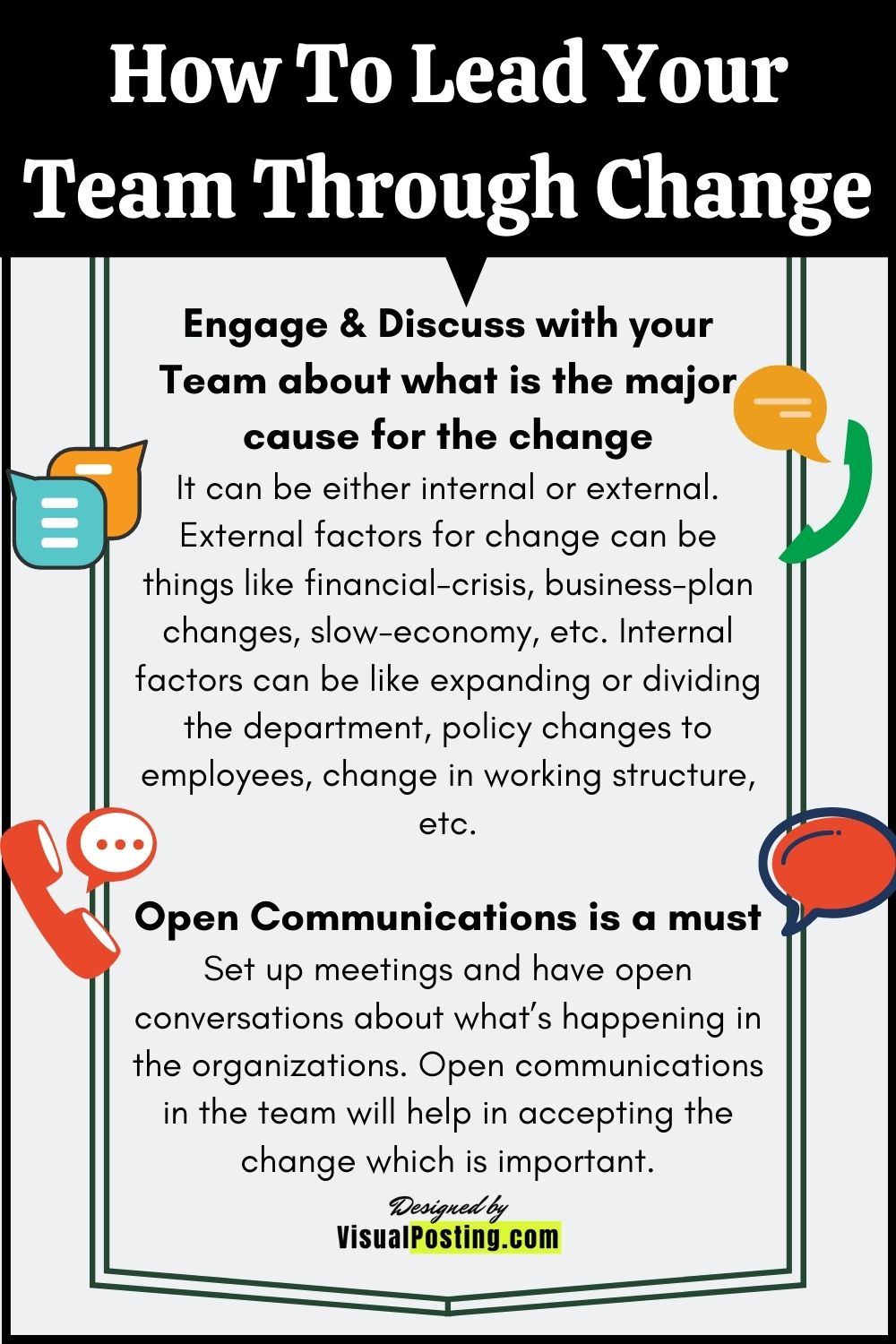
Engage & Discuss with your Team about what is the major cause for the change
It can be either internal or external. External factors for change can be things like financial-crisis, business-plan changes, slow-economy, etc. Internal factors can be like expanding or dividing the department, policy changes to employees, change in working structure, etc.
Open Communications is a must
Set up meetings and have open conversations about what’s happening in the organizations. Open communications in the team will help in accepting the change which is important.
Conduct brainstorming sessions and find out the level of the team
Discuss with your team everything regarding the changes happening. It can be about financial, operational or organizational-structure changes. Discuss. Do brainstorming. Be open-minded in accepting the ideas and creative solutions to tackle the team through changes.
Create a Contingency Plan/Strategic Plan
Explaining clearly about the organizational changes will help employees understand how it is going to impact them. They will assess the solutions, realities, contributions that can be done and such. This clear idea will make it easy for the team to prepare a contingency plan or a strategic plan during the changes.
Discuss the End-Result or End-Goal
It helps the employees, team members to better prepare themselves. It is important to explain how the end goal or impact is going to affect them during organizational changes. It is like giving your team some time to take a deep breath before proceeding further during the changes.
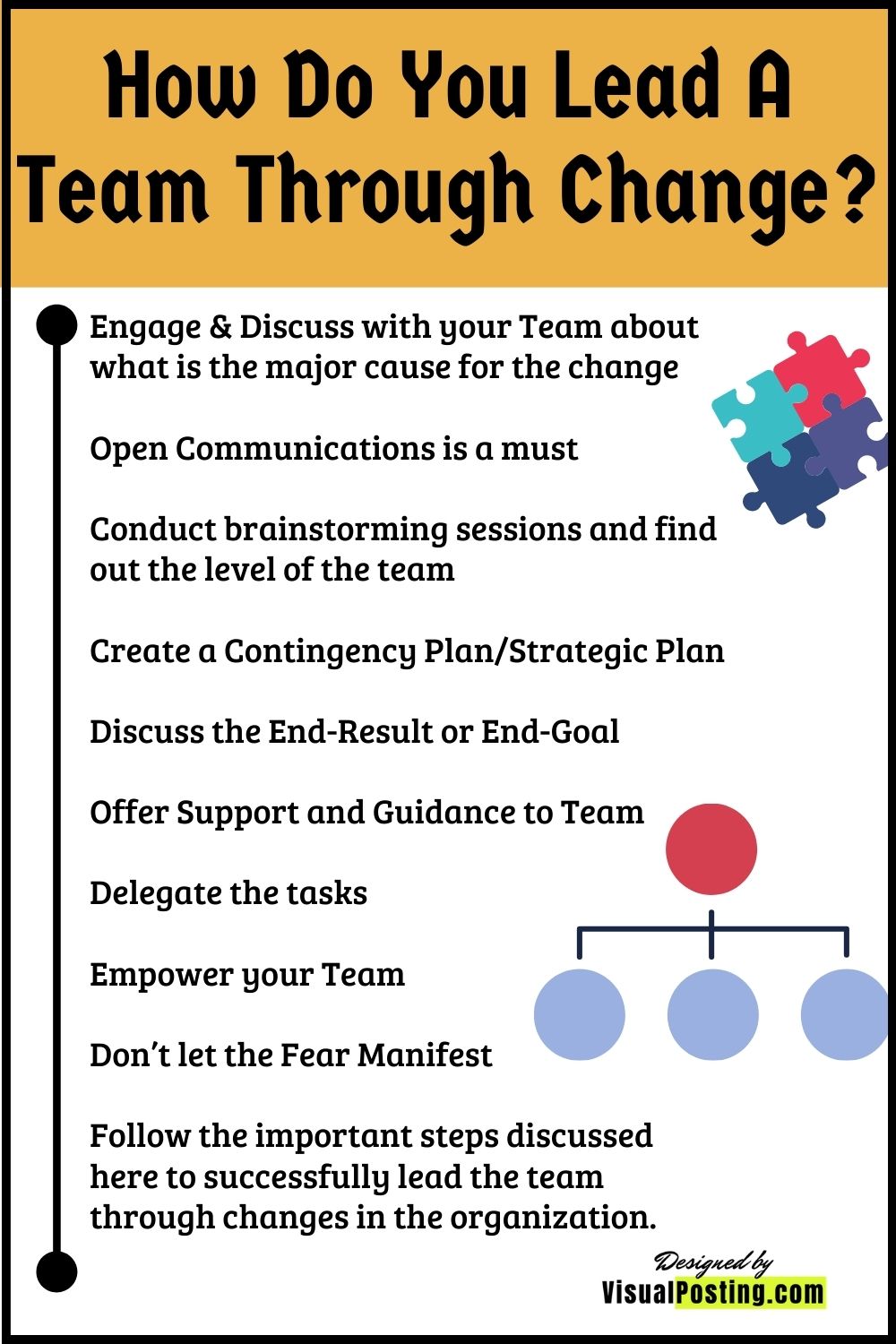
The challenging times of being a team-head comes when you have to lead the team through organizational changes. We like to share with you a few ideas and tips to successfully lead your team through changes easily and smoothly.
Engage & Discuss with your Team about what is the major cause for the change
Open Communications is a must
Conduct brainstorming sessions and find out the level of the team
Create a Contingency Plan/Strategic Plan
Discuss the End-Result or End-Goal
Offer Support and Guidance to Team
Delegate the tasks
Empower your Team
Don’t let the Fear Manifest
Follow the important steps discussed here to successfully lead the team through changes in the organization.
Learn strategies for dealing with overpowering personalities on your team. Foster collaboration, communication, and mutual respect for a harmonious work environment.

Don’t Interrupt
This is the part where it gets difficult to handle a dominant team member. Interrupting them only aggravates their behavior. If situations are unavoidable and the dominant team-member has taken the stage, leave it. Don’t interrupt. Don’t let others interrupt too. Let them do what they do. The careless attitude from others will make them step down soon.
Do not show Interest.
Don’t Nod or Smile or accept by shaking or tilting head. Just ignore them. Be neutral without showing any interest. It’s an easy way to handle a dominant team-member. They will eventually step down when they don’t get the attention they seek.
Do the Opposite
Dominant persons will consider everything they said of so much value. Do the opposite here. The more they speak, the less your feedback should be.
Take only the core
Leave the rest and only speak the core issue with them. Let all the unwanted things (they will feel it is important) said by them. The dominant team member will understand.
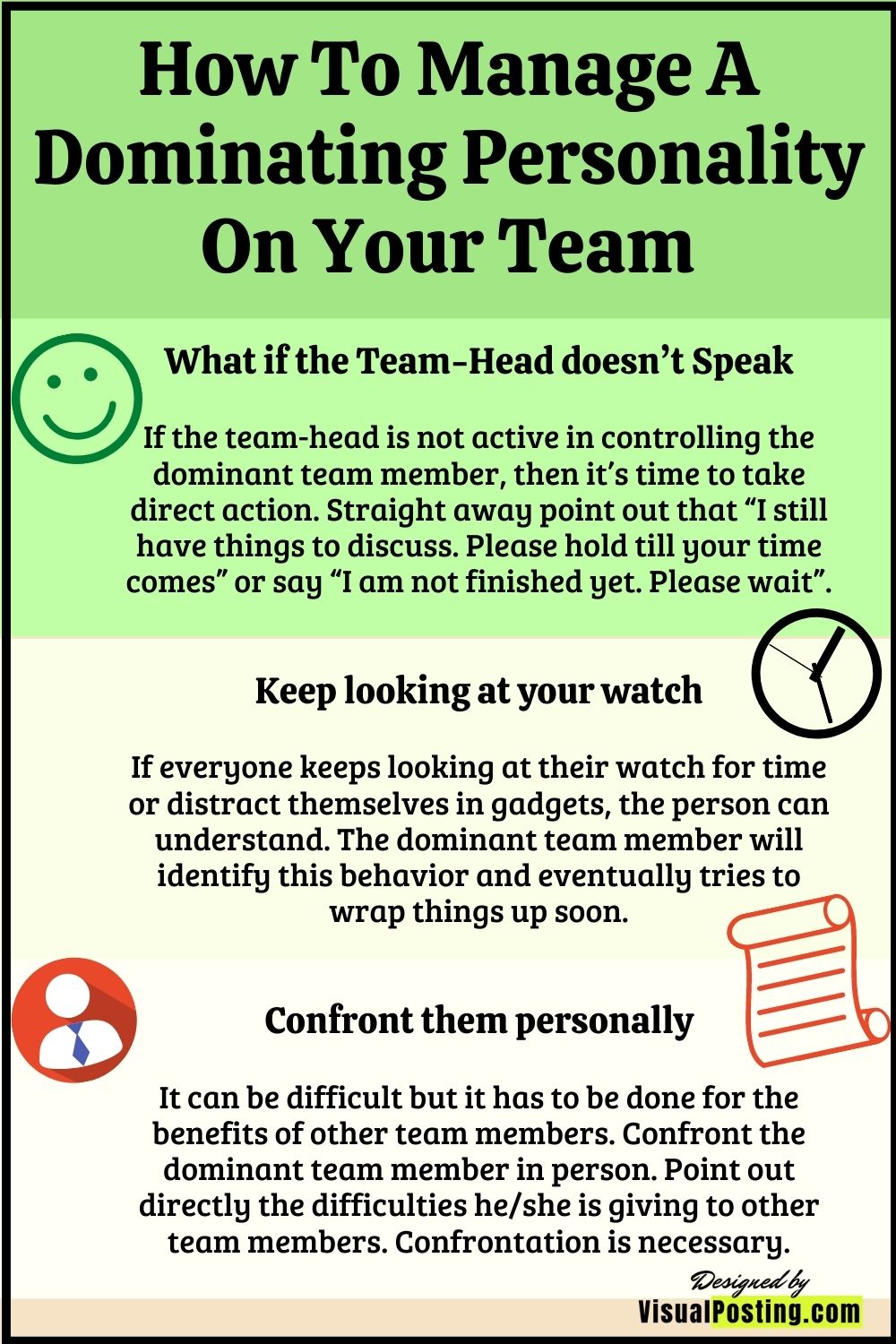
What if the Team-Head doesn’t Speak
If the team-head is not active in controlling the dominant team member, it’s time to take direct action. Straight away, point out that “I still have things to discuss. Please hold till your time comes” or say, “I am not finished yet. Please wait”.
Make them understand that there is a Control.
Any dominant team member will not wait for anyone. They have to take the floor no matter what happens. If so, make them understand that there is still someone top to control.
Often, keep reminding them that other people in a team need space. A manager or team-head should act. If no one interrupts them, they will have a sense of authority.
Keep looking at your watch.
If everyone keeps looking at their watch for time or distracting themselves with gadgets, they can understand. The dominant team member will identify this behavior and eventually tries to wrap things up soon.
Confront them personally
It can be difficult, but it has to be done for the benefits of other team members. Confront the dominant team member in person. Point out directly the difficulties he/she is giving to other team members. Confrontation is necessary.
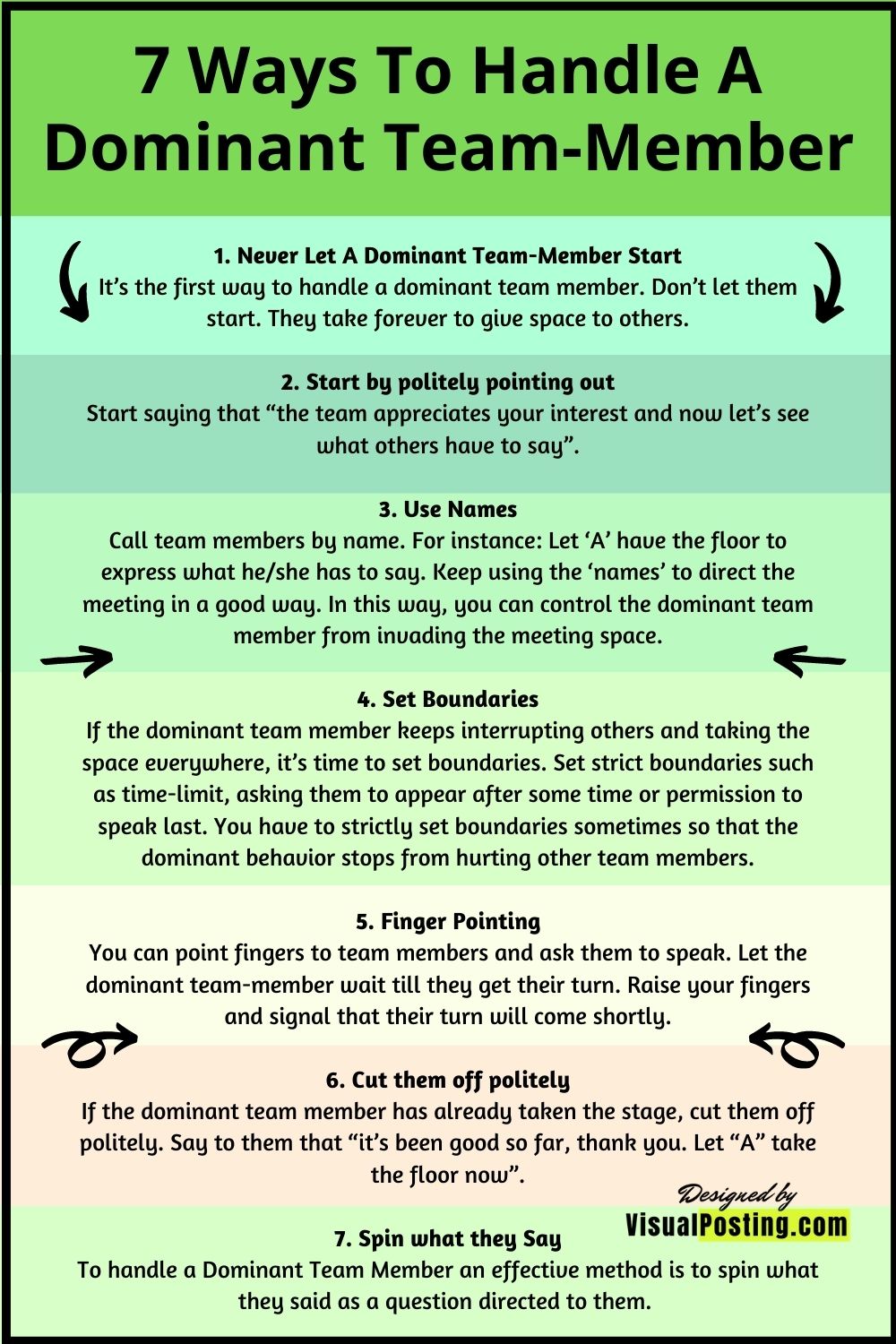
Simple gestures and methods from your side and you can handle dominant team members easily. They are:
1. Never Let A Dominant Team-Member Start
It’s the first way to handle a dominant team member. Don’t let them start. They take forever to give space to others.
2. Start by politely pointing out
Start saying that “the team appreciates your interest and now let’s see what others have to say”.
3. Use Names
Call team members by name. For instance: Let ‘A’ have the floor to express what he/she has to say. Keep using the ‘names’ to direct the meeting in a good way. In this way, you can control the dominant team member from invading the meeting space.
4. Set Boundaries
If the dominant team member keeps interrupting others and taking the space everywhere, it’s time to set boundaries. Set strict boundaries such as time-limit, asking them to appear after some time or permission to speak last.
You have to strictly set boundaries sometimes so that the dominant behavior stops from hurting other team members.
5. Finger Pointing
You can point fingers to team members and ask them to speak. Let the dominant team-member wait till they get their turn. Raise your fingers and signal that their turn will come shortly.
6. Cut them off politely
If the dominant team member has already taken the stage, cut them off politely. Say to them that “it’s been good so far, thank you. Let “A” take the floor now”.
7. Spin what they Say
To handle a Dominant Team Member an effective method is to spin what they said as a question directed to them.


